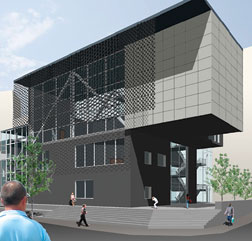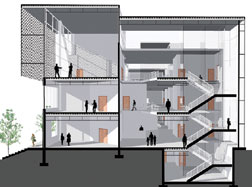 |
 |
 Students at University of Minnesota generate BIM models. |
As industry acceptance of BIM grows, colleges and universities are trying to work it into their long-established architecture and engineering curricula, with mixed success. While BIM evangelists see great potential in teaching it to the next generation of engineers, architects and construction managers, many academics and professionals are not yet fully convinced of the still-evolving technology's value in a slim-margin construction world.
"BIM is really a cultural revolution for the construction industry," notes Willem Kymmell, a professor of construction management at California State University, Chico, and the author of a forthcoming book about BIM systems. "BIM has usually been seen as being for architects, but many of our students studying construction management are showing great interest in its applications in project scheduling."
While a great supporter of BIM, Kymmell says that it should not be feared as a replacement for a traditional education in architecture or engineering. "BIM is a fantastic visualization tool to give students the complete picture of a project, but I regret that many schools are taking traditional hand-drafting out of their required curriculum and are putting students right into computer modeling," he says. "Computer models are valuable, but you can't draw construction detail without understanding it."
Most schools that teach BIM today generally offer it only as an advanced course and are reluctant to let students tackle it before they have mastered the basics. "Knowing how to make a model doesn't actually solve problems," Kymmell contends. "There is a big difference in knowing what to do with the computer and what to do with the result."
Learning to think in terms of BIM is a challenge in itself. Instructors find that its new approach to design and construction demands new methods for teaching the construction process. "The problem is in teaching collaboration," says Kymmell. "BIM allows the different skill areas of construction to interact, but how do you teach students to benefit from this?"
BIM has encountered similar cultural hurdles from within the industry itself. Firms sometimes use eye-catching 4D BIM renderings to impress clients, only to shelve them afterward for more established methods. While BIM may be derided as little more than fancy modeling, supporters in the academic world cite the underlying data management as its true usefulness.
F.H. "Bud" Griffis, a professor at Polytechnic University, Brooklyn, N.Y., and a longtime advocate of BIM. "There are geometric databases, and you can attach attributes that are tracked throughout a project." All civil engineering undergraduates at Polytechnic must take a two-semester BIM course, includeing the BIM model submitted with their senior project.
Students are encouraged to forgo tweaking models endlessly and to concentrate on finding meaningful applications for the attached metadata elements. "One of our students is using BIM to work out how to minimize a building's carbon footprint using the databases," says Griffis. "Once you've seen your structure in 3D with all the databases, it is very hard to go back to plain 2D or 3D drawings without the attached content. You feel handicapped."
Griffis says he has been somewhat ahead of the curve in applying BIM for some time but observes that "we are seeing more and more of it in the industry today, and students are able to take their BIM experience into the field." He involves his students with actual industry BIM projects, including several efforts with construction giant Bechtel. "Bechtel is most advanced in the world at BIM right now, and students can see the technology's benefits by studying its use in real-world projects," he says.
The most vocal advocates of BIM in higher education today are often technology vendors that make the required software. Although companies such as Autodesk, which produces Revit, Bentley Systems, whose BIM tool is Microstation, and others...
 Related Links:
Related Links: 
Post a comment to this article
Report Abusive Comment